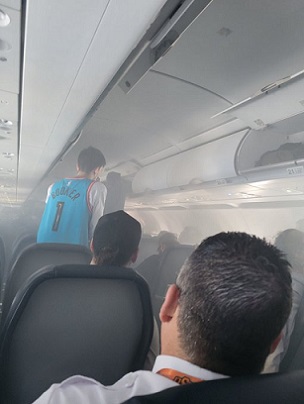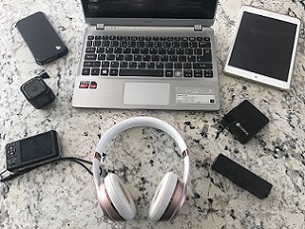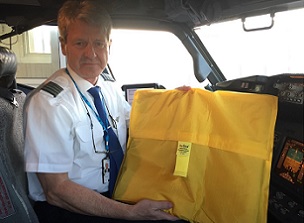 Toxic smoke filling an aircraft passenger cabin after a battery charger catches fire in an overhead locker
Toxic smoke filling an aircraft passenger cabin after a battery charger catches fire in an overhead locker
 All these everyday electronic items are powered by lithium batteries
All these everyday electronic items are powered by lithium batteries
 A pilot with an AvSax lithium battery fire mitigation bag
A pilot with an AvSax lithium battery fire mitigation bag
At least one lithium battery fire incident is happening on planes in the US every week on average, latest figures have revealed.
The Federal Aviation Administration in the USA compiles information on each one reported to it regarding personal electronic devices such as mobiles phones, laptops or even vapes overheating or catching fire on US planes or aircraft in US airspace.
Other fires will have happened on planes throughout the rest of the world but not recorded.
The FAA officially recorded 54 last year and in just one month from June 22, 2022 to July 22, 2022 there were 10 incidents including three in just ONE day, July 22. Read more about this by clicking here.
The FAA warns: “These are lithium battery related events involving smoke, fire or extreme heat that the FAA is aware of and should not be considered a complete listing of all such incidents.”
There have already been incidents this year with the most recent ending with 10 passengers needing hospital treatment.
The FAA started recording lithium battery fires in March 2006 and since then well over 400 incidents have been recorded – mostly on passenger aircraft - involving 178 battery packs, 81 e-cigarettes or vapes, 51 mobile phones, 48 laptops, 51 other electronic devices and 2 medical devices.
In 2014 only 9 incidents were recorded and 14 in 2015 which shows just how the number of incidents has increased alarmingly in recent years. There were 54 recorded in both 2021 and 2022.
In the most recent incident 10 people needed hospital treatment after a fire on board a passenger plane was sparked by lithium batteries overheating and catching fire.
The emergency happened on a Sprit Airlines airbus when toxic smoke filled the cabin as the crew battled to douse a burning battery pack charger in an overhead locker.
The aircraft flying from Dallas in Texas to Orlando in Florida on March 1, 2023, was forced to divert and make an emergency landing at Jacksonville International Airport in Florida, 156 miles from its destination.
Crew and passengers, including a retired firefighter, tackled the fire as smoke filled the cabin with one passenger suggesting it took 20 minutes to put the fire out.
Those taken to hospital included passengers and crew, but none were badly hurt.
Passenger Joseph Fleck said on Twitter there were more than 170 passengers on board and described the smoke as ‘toxic.’
The incident shows the importance of having lithium battery thermal fire containment bags on board as incidents like this can then be dealt with almost instantly.
The world’s best-selling lithium battery fire mitigation bag is the AvSax now on board around 16,750 aircraft operated by more than 100 airline companies. AvSax have been deployed in action at least 33 times on board aircraft since 2017 and on every occasion the aircraft was able to continue safely to its destination with no need to divert or make an emergency landing.
Passengers routinely take hundreds of personal electronic devices such as mobiles phones, iPads and laptops on every flight on all airlines worldwide. All these devices are powered by lithium batteries and there is always a danger one could overheat, catch fire or even explode.
When it overheats it goes into a chemical process called thermal runaway and when this happens one cell in a battery overheats it can produce enough heat – up to 900°C (1652°F) – to cause adjacent cells to overheat. This can cause a lithium battery fire to flare repeatedly and they are then very difficult to put out which is why it must go into a lithium battery fire containment bag as quickly as possible.
AvSax was devised and manufactured by Environmental Defence Systems Ltd based in Yorkshire, England, and won the Queen’s Award for innovation in the UK, the highest accolade any business can achieve..
Managing director Richard Bailey said: “The number of lithium battery fire incidents continues to rise on passenger planes and the last thing you want is a toxic fire like this at 30,000ft in the confined space of an aircraft cabin.
“These fires can take hold very quickly sending out sparks, flames and smoke so it’s vital they are doused quickly using a fire extinguisher and then put in an AvSax which is made from military grade material so will contain it, even if it explodes.”
How do AvSax lithium battery fire mitigation bags work?
If an electronic device starts to seriously overheat or emit smoke the cabin crew will pour at least two litres of water into an AvSax.
It is imperative to first knock down the flames from the device using an on board halon fire extinguisher, then transfer the device into the AvSax before it reignites. Additional water may then be added, up to 20 litres.
The water disappears into the sides of the AvSax, activating the polymer gel inside the bag and causing it to expand around the device. Should the device keep on venting then the AvSax is tough enough to absorb the energy.
The AvSax cools the batteries in the device, reducing the likelihood of the battery igniting but if it does go into thermal runaway it’s all contained within the bag. The AvSax is made from military grade material so should it explode then the heat and debris will be confined within the bag.
For more information on AvSax go to www.avsax.com